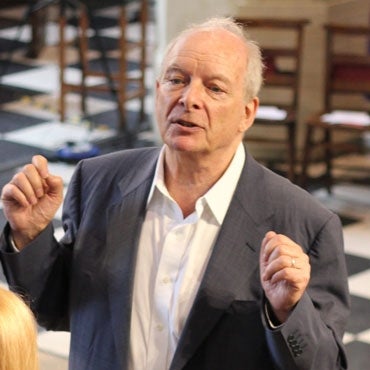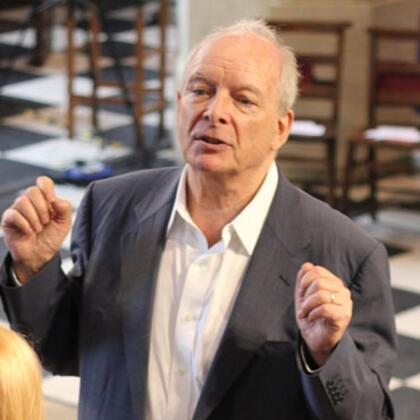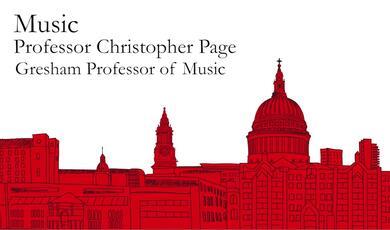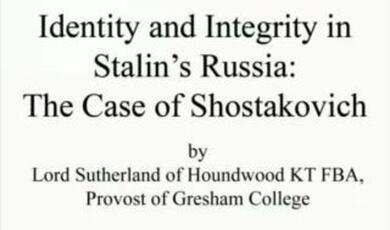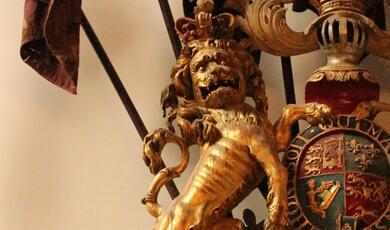Paris: Debussy and Ravel
Share
- Details
- Transcript
- Audio
- Downloads
- Extra Reading
Debussy's Sonata for Flute, Viola and Harp is contrasted with Ravel‘s very different Sonatine for the same combination.
Rehana Browne flute
George White viola
Mary Reid harp
This is a part of the series of lectures and concerts, European Capitals of Music.
Famous musical capitals provide the framework for this series of lectures with live music. The first three concentrate not only on 19th century Vienna, but on Schubert in Vienna and writing chamber music. Why did this music happen then, where was it played, who provoked, preformed and paid for it. And was it considered successful?
The final three ask similar questions of other capital cities: 20th century chamber music in Paris, baroque music in London under the shadow of Handel, and virtuoso violin playing in Rome focused on Corelli, the 300th anniversary of whose death is being celebrated this season.
The works in each programme are played by present members of the Royal Academy of Music.
Download Transcript
7 March 2013
European Capitals of Music:
Paris
Professor Christopher Hogwood
R = Rehana Browne (flute); G = George White (viola); M = Mary Reid (harp)
Good afternoon everybody and welcome to this fourth lecture in our famous cities of music series. You had a fairly comfortable ride for the first three, being Vienna in a very Biedermeier style with Schubert. Less comfortable today, I am afraid: this is Paris in wartime. So, because, in France, they do things differently, I thought we should probably do the same and, instead of a lot of talk and then you hear the music that we are talking about, we might reverse the process and actually give you some music first, for various reasons. I think the style of French impressionistic music and modern music in general is something that not everyone carries a vivid picture of in there mind. When we are talking about specific combinations of sounds that are unusual, music that deals in atmosphere and more in hints than statements, this is very elusive music. It is very hard to pick it apart and equally hard to talk about it, unless these sonorities and this atmosphere is already pretty firmly lodged in your mind.
I will just set the picture: this is 1915, wartime Paris. Debussy is at the end of his life, knowing that he has cancer, setting up to write a series of sonatas, somehow reflecting backwards on the great days of France and the natural supremacy of France, and he signed himself, on these late sonatas, always, “musician Francais” - he wanted to show that there was a patriotic side to this. More on the details, the sonorities and the problems of actually listening to this music I think after we have heard the first movement of this trio, which is a pastorale, and here is our lovely trio from the Royal Academy to play the first movement of the trio for harp, viola and flute.
[Music plays]
That is usually the moment in concerts where you hear some little child saying to its parent, “Is it over?”!
There is quite a lot of uncertainty in this music, and this is one of the things I wanted to deal in a little bit today, the business of how you listen to this music and how you prepare your mind for this sort of writing.
Now that you have this sound-scape in your mind, I think it is a good moment to talk about the actual sonorities because, as everybody finds, you need in this music to have a picture of how the sounds are being prepared, what they are doing and what they are hinting at. I cannot say that there is anything more definite in terms of description. I think we probably all feel we have heard something that suggested something or touched on and then left, and also where it is quite difficult to speculate what might come next, if anything. Maybe it was the end, maybe there was more… So, this idea of uncertainty in terms of expectation but also voluptuousness in terms of the actual sounds that are.
The group is an odd group – no personal significance here – but how often do you have to get together and play as a trio? I would say not so often, because the repertoire is small. Debussy’s idea had been to write six sonatas in a homage, I think, to eighteenth century sets of mixed sonatas that were published, as a French musician at a time of great difficulty, when, since 1880, the going style in Europe of course had been that set by the style, harmonic, melodic and conceptual, of Wagner. It was no good if you were French, in the middle of World War I, to be doing anything that had similarities to the Wagnerian school, and so you have a completely different philosophy, formulated by people like Saint-Saens, and then taken on through French composers in general to cultivate the essentially French characteristics – delicacy, sonority, impressionistic approaches to ideas rather than fully-fledged, described and carried out at full length.
You have instruments though in a combination that is very unexpected, and had Debussy lived, we would have had even more. The sonatas we have got, from the set of six, are: the Cello Sonata, cello and piano, perfectly normal; Violin Sonata, violin and piano, ditto; this trio, which is a very unusual combination, and, in fact, where the viola was originally going to be an oboe, and you got swapped, for various reasons we can discuss. The sonatas we did not get, I find very tantalising, especially the next one in line. We were due to have a sonata for French horn, oboe and harpsichord, again, an unheard of combination of instruments, but again essentially French sonorities. There was then going to be a sonata for clarinet, bassoon, trumpet and piano, again nothing that we had met with before; and the last of the six, Debussy had only said would be some form of piano and a combination of the instruments that had been heard before. So there was an encyclopaedic look to this and, unluckily, we only have half the set, and this is by far the most unusual.
All the instruments that come here come with a certain amount of baggage, and I think one has to assume that Debussy and his audience reckoned on this, and we need to reckon on it as well, so, as it were, going round the circle, the flute comes with specific baggage. I do not know how you see the flute as a pure, delicate, pastoral, simple, classical instrument, whatever your associations. For Debussy, it is quite clear, because we know what the flute had previously been used for in his music. This is “L’apres-midi d’un faune”, the tone poem that everybody knows, and this is essentially placed in the hands of the flute to set this pagan, sunny afternoon atmosphere.
[Music plays]
You will notice you are never quite sure where it is going to stop, when it is going to stop, was that a cadence, was that the end of the sentence, was that the full concept. You find that typical of Debussy or typical of the flute…?
R: Yeah, I think it is quite typical of Debussy, and that was an orchestral piece, so you can really play with the colours of the other instruments in the orchestra, and that was also evident in some of the sonata as well, particularly between the flute and the viola. The lines can be passed, so you are not quite sure when one starts and when one ends.
Exactly, yes – there is a lot sharing, you notice already in the movement. It is not that you are listening to three instruments. Sometimes, you are listening to one instrument. Sometimes the viola and the flute appear to be the same instrument. When you play in unison, you have created a new sound, which is a single instrument but two people.
There is a solo piece for flute, which, since it is so short, would be very nice to hear in this context. This is one that Debussy wrote as a piece of music, we think, to be played off-stage in the interval of a scene change with one of his ballets. He called it, first of all, “Pan”, and then he realised he had already used that name on other music and so he changed it to “Syrinx”. Syrinx was the nymph who was chased by Pan. She turned herself into a reed, and Pan cut this reed in order to make a flute, thereby killing the person he was chasing, but the connection between Pan and reeds and the flute very natural, very pastoral, not in the least bit Christian, certainly Pagan, and I think it is fair to say the only really substantial piece for solo flute since the Bach family…
R: Yes.
It is very strange that, from the eighteenth century, when there were pieces written for the flute, without any accompaniment, other than flute studies and technical pieces, Doppler and so on, we wait until, oddly, until Debussy to create this wonderful and short piece. If you want to get the real impression of it being played off-stage, here, it would be a shame because we would leave the podcast with nothing to look at! Close your eyes and you can imagine it off-stage, “Syrinx”…
R: A real duel of restrained emotion, of sadness, of elastic beauty, of discreet tenderness and poetry…
[Music plays]
An awfully good piece in this acoustic! I do not know whether you will get a better bathroom acoustic than here, but it is lovely for solo flute!
That fixes, I think, the flute in Debussy’s mind and music very well for us.
Going round the circle, the harp comes with other baggage, not only Debussy and with no sort of signature piece. I think traditionally, of course, we must associate the harp with angels, dreams, angels in paradisum. It is voluptuous. It usually gives, at least to me, the impression of there being more notes than I actually need, being in the nature of the instrument that you can strew notes around very lavishly, and I suspect, because of more recent connections with Hollywood, it has achieved a symbolism of the harp arpeggios play and its regression to childhood, flashback in some films and, in more advanced films, it usually means medication taking hold. You have to probably get these ideas out of your head slightly! But the traditional harp style is not so close to what Debussy made it do, but from people like Faure, we have – you can show us, I am sure – the sort of things the harp can do. One of them is stopping the string halfway up and getting the effect of a harmonic, a bell-like tone…
[Music plays]
The real note sounds quite full-bodied. This disembodied one goes very well.
Of course acres of arpeggios, all fixed for their tuning by the many pedals that have several positions, and you set up the entire instruments and then you have – it is very easy to run from top to bottom, I think, and have more notes than you actually need, but a wonderful effect of sonority and sensuality and voluptuousness. A little Faure for us…
M: The piece is Faure’s Impromptu and it was written in 1904 by request of Alphonse Hasselmans, who was the harp teacher at the Paris Conservatory, and this is just the opening of these piece.
[Music plays]
A perfect example of what I would call the best generous harp style, and it is the one that we are mostly familiar with, either solo or in orchestral music – lavish.
Immediately, you can see therefore that what Debussy was doing in the trio was very rationed. I think he was selecting individual notes quite carefully, and single points and single harmonics, and one small arpeggio at the beginning, just six notes instead of 1001 notes. So there is a restraint and self-denial going on, I think, in that Debussy scoring, which is only apparent if you take the harp plus its history.
The flute, on the other hand, seems to play cascades of notes in the trio and many people, of course, do not really believe that that is completely notated, so one should say every note in the trio was written and every placement of every note. It was not an extempore event, although it gave the impression of being sometimes very wilful sketches that begin and end, ad libetum, but in fact, everything is highly calculated.
Ending with the viola that might have been an oboe, there is not so much that is unusual, I think, other than the fact that, if it had been an oboe, it would have been higher pitched – it would have worked in an area much closer to the flute and been a competition to you. I think it was a great idea that he took you down.
[Music plays]
These nuances matter enormously in Debussy, and he marks them in the music more carefully I think than almost anybody else prior to his writing, for various reasons: to give you a greater tonal palette from a single instrument; also because I think he is aiming to confuse the air – impressionism, although he himself did not like that term, this idea of suggesting something can be done also by confusing the ear. There are nice moments when you and the flute play together or exchange lines, and in fact, we know we are looking at three instruments, but in fact, musically, we are only really hearing two, and the composite instrument, the sound of the flute and the oboe in pure octaves, gives us an orchestral effect, of a totally different dimension. A little sample…
[Music plays]
For a moment, you think you have one instrument, then you suddenly realise it is split into two-ways and the harp has confused us slightly with a chord which was neither starting nor stopping but somehow a midway suspension. You will come across that in the second and third movement of this trio.
One question that is asked by a lot of people when they start observing the stylistic differences of French music is the question of: Can music actually speak French? You notice with even symphony orchestras, who are completely impervious to any idea of stylistic differences in music and they will play everything from Bach to Bartok in exactly the same tone colours and styles, they nevertheless, even the most stubborn of them, make a special effort to do something different when they get to French music. They play with less pressure, would you say? They do not shout at you. They put a dreamy look on their faces. They observe an awful lot of rubato and wafting around, and a general feel of what the Dutch musicians rather rudely call the style, “dusting the mantelpiece” – wafting over things in a generic sort of way, without coming to earth anywhere, and it is very difficult to pin this down. It is a characteristic of impressionism, and it is something not limited to music.
We are short on language for all these things, but one has to find a way of getting to a defining point, both for painting, for French poetry, for cooking even, tastes and so, are very difficult to pin down in such a way that we all agree we are tasting or seeing or hearing the same thing.
One of the tests I think for this question of sonorities being used for different purposes is whether you can use them as a translator, that is, not only in a work that is specifically scored for this strange combination of instruments, but it is a tempting sound once you have heard it. Surely there must be other music that would benefit from being absorbed into this sound world.
To balance up the sound world of Debussy, we are going to play you one movement of an arrangement, again French – this is the first movement of the well-known Sonatine for Piano, which we perhaps hear a little bit on the piano… This is what Ravel wrote…
[Music plays]
Again, a completely different musical world to Debussy – this is music you can go home singing. I defy you to go home singing the themes from the Debussy trio, but you could easily go home humming that Ravel. He repeats himself; he has harmonies that are clearly cadential. You know where you are in the structure. There is no mistaking that composer for Debussy.
By taking the Debussy sound world though and adding it to this music, you begin to ask yourself: was that really piano music that you heard or was it music written on the piano to give an impression of the harp or the orchestra or the flute? And in fact, when it is translated to these instruments, does it do a good job or does it spoil this ambiguity by becoming explicit? What sounded a bit harp-like in arpeggios on the piano now becomes specifically harp-like and specifically flute-like. It is a lovely dilemma and one I am sure that Gaelic mentalities love to see us struggling with. You do not have to come to a conclusion, but you have to just observe that this ambiguity is available.
Could you just tell us about this arrangement, because this was made by the Head of Harp Studies at the Royal Academy?
M: Yes, this arrangement was made by my teacher, who is now Professor Emeritus at the Royal Academy, and she played with the National Ensemble for many, many years and made this arrangement to play, and they premiered it in the beginning of the 1990s, but she only published an arrangement for all harpists to use just last year. A famous French harpist had made an arrangement for harp, flute and cello during Ravel’s lifetime, and he heard that arrangement and thought it was very good. Violists have been stealing the cello part for years, since that arrangement was made, but now this arrangement is specifically written for the viola, not for cello.
[Music plays]
That is music speaking French in French dress. You have to put aside the question of whether the dress or the body underneath are the main topic, and there is, of course, a view of particular people who are not very fond of French music that it is all dressing and no body, that the whole thing is a form of camouflage, but the camouflage is very strongly connected I think to the message, and that music, you can hear, is self-confident, it is not aggressive, it does not worry you, it is not threatening.
What Debussy does, by using the same sounds, is, I think, very different, and it does carry rather worrying undertones, and it does not have the surface finish or the gentlemanly balance of the Ravel. The problem with Debussy’s music is that it does not really lend itself to formal analysis, for various reasons. In the traditional sense, you cannot take it to bits and put it together again because it is not so much concerned with structure and what happens after what or why, and it does not really encourage our usual expectations. When Ravel comes to a nice dominant seventh chord there, he goes on with the resolution and the whole thing falls into place. Debussy, even if he got to something as simple as a dominant seventh chord, would probably have stopped dead and leave you wondering what was happening next, until you realised it was the end of the piece. The normal reactions are not called for, so you have to go through a certain process of emptying your mind of traditional expectations and letting things flow. He, in a way I suppose, intentionally would want his music to be classified as vague, because to pin down the actual steps of the dance is less poetic than to suggest a dance is taking place, that each of you can just see and imagine in some way, without the specifics being allowed. So it is expectation denied, and although people dress it up in different words, I think it lies at the root of many people saying modern music, and especially modern evasive French music, is something they cannot follow because they do not know where it is going, what is going to happen next. Do not worry – nobody knows what is going to happen next!
There is one very nice quote I will give you, which is the critic Leonard Meyer, who dresses up in fine critical words what we all think. He says: “In the absence of emphatically goal-directed processes and conventional, formal schemata, the ordering of successive events in Debussy often seems problematic. Events come after one another, but they cannot be readily understood as following from one another.” A rather grand way of saying we have no clue what’s coming next…!
I think it is important not to use that as some form of self-criticism but to say that is what is expected: you should be able to take whatever comes next, as we do in Ravel. I mean, the normal words that go in standard commentaries, I will just give you a few of those, because we all know how people write about Debussy. There is, in the standard programme note on this piece: tonal ambiguity; [tamboural] austerity; ambiguity of harmony and form; fragmented, halting phrases; [pontilistic] use of colour – then we are into the art critic world. All these things are to say it is not quite clear what is happening and it is not meant to be quite clear, nor what could come next.
Debussy himself was a little bit worried by the piece, I have to say, because he wrote to Stravinsky and admitted he was worried about the war situation and he was hoping that, by creating, as he said, these works with reverence towards the past, that “…some new beauty should fill the air when the guns fall silent”. He did not live long enough to see that.
He also admitted that, in the writing of this music, where he was consciously going back to another style of his own and another age, he said, of himself, that: “It is the music of a Debussy whom I no longer know – it is frightfully mournful, and I do not know whether one should laugh or cry or perhaps both.” So, even he had no idea of what the expressive ambiguity was going to lead to, so you do not have to worry I think that it exposes this and does not decide it, so we do not have to make the decisions on this music.
The second and the third movements – another warning I should perhaps give you about French music, and Debussy in particular, is never trust their titles. They are usually no help at all. The first movement was called “Pastorale” that you already heard; the second movement of this piece is called “Interlude”, is more pastoral actually than the first one, and it is in the tempo of a minuet – do not dream of dancing a minuet to it because half of it is written in four-four, not in three-four, and it is very hard to tell where the metre shifts I think. Unless you raise your eyebrows, we will not know when we have gone from three to four. It is evasive. The last movement is called “Finale”, which again does not tell you very much!
It does have, of course, elements that you can see Debussy sprinkling onto the music like spices to give you a new type of cuisine. One of them is, I think, rather exotic, but I get that same feeling when you played “Syrinx”, that there was something slightly morbid and North African about these little semitones drifting around. It sounds like improvised music from a source which is not the European concert hall, and I think I get this feeling with particularly the viola – I mean, the viola does things you do not expect a self-respecting viola should be uttering in public!
[Music plays]
It does not make any sense at all I think on its own, and in context, it gives you a composite effect, but again, I am not sure that the sense becomes any clearer, but the way that you are integrated with the rest, it certainly reassures people that the piece is notated and it is not one giant improvisation.
I think what everybody feels in the first movement of that trio is you are never quite sure if there is a beat: is it going to stop or has it stopped? Is there a pulse? In the second movement, certainly he gives you the tempo of a minute, in three, and there is a pulse but it is always being contradicted or ignored. In the last movement, I get much more the feeling that rhythm now has to come in or we are going to be starved of something, and luckily I think the viola does rather well, so these propulsive things and little comments and snappy things. It is certainly not inert music and it is certainly what in other hands this sort of scoring might turn into being a sort of decorative camouflage. Often something which is expressive and impressionistic can veer ever so slightly off-message and it becomes either uncommitted or purely surface decoration, and I think every note of Debussy is very intended and he wants you to feel something at that moment, but not necessarily to have any expectation of what the next moment might bring, and there are some shocking shocks in this music.
Anything we have not said about this piece that you feel the public should be aware of…?
It is mysterious. You have to remember that this repertoire, until very recently, was dismissed as rubbish. All these last sonatas of Debussy were, if you read any older criticism, are basically put aside as saying Debussy was ill, he did not quite know what he was doing, they are not really finished, they do not carry a message, he had to have something to publish and just did the lightest job, and gradually, I think we are beginning to find that there are the sort of nuances in them that show up when we do not ask the old-fashioned questions but, as it were, open our mind out.
So, blank out your minds and just let the story start. You have two movements: one said to be in the tempo of a minuet; and the other one truthfully said to be the final movement of the trio.
Thank you.
[Music plays]
© Professor Christopher Hogwood 2013
Part of:
This event was on Thu, 07 Mar 2013
Support Gresham
Gresham College has offered an outstanding education to the public free of charge for over 400 years. Today, Gresham plays an important role in fostering a love of learning and a greater understanding of ourselves and the world around us. Your donation will help to widen our reach and to broaden our audience, allowing more people to benefit from a high-quality education from some of the brightest minds.


 Login
Login
